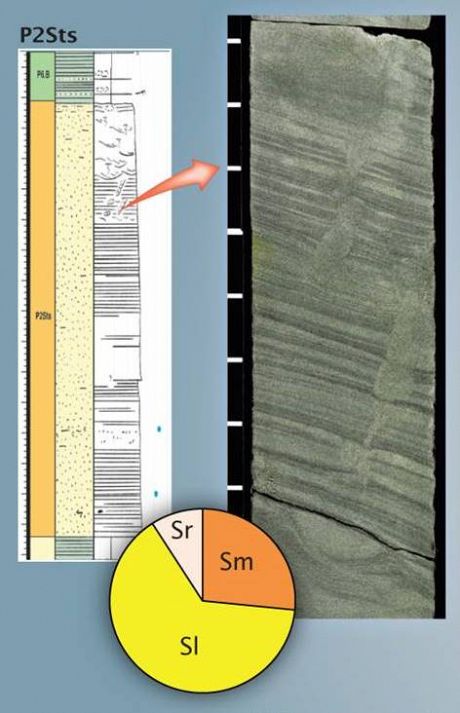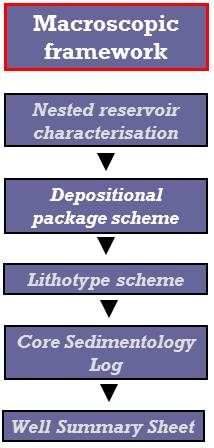
Course summary and outline
At a small scale, the nature of sedimentary and biogenic structures commonly provides an indication of depositional processes and environments, from which sandbody types and associated shale geometries can be inferred. Their variable architectures and heterogeneities are outlined in this course, together with the impact on permeability anisotropy and resultant fluid flow from the plug to the reservoir scale. At a large scale, paralic successions commonly change character across key sequence stratigraphic surfaces. This course offers insights into stratal surface recognition in order to define a robust layering framework for reservoir modelling. The concepts introduced during the course are underpinned by real subsurface examples from Kuwait represented in the form of a series of case studies. These are accompanied by exercises. The workshop is organised into two sessions:
Part B: Case study examples - subsurface of Kuwait
• Burgan Formation
• Wara Formation (south Kuwait)
• Zubair Formation (north Kuwait)
Part A: Paralic sediments as hydrocarbon reservoirs
• Introduction to paralic sediments - why are they important reservoirs?
• An overview of paralic depositional settings and types of reservoir sandbodies
• Coastal process classification - the role of fluvial, wave and tidal processes on reservoir architecture and heterogeneity
• Deterministic framework - key controls on paralic sedimentation, recognition of key stratal surfaces and stacking patterns, and correlation approach
• Heterogeneities and permeability architecture - the implications
• Introduction to paralic sediments - why are they important reservoirs?
• An overview of paralic depositional settings and types of reservoir sandbodies
• Coastal process classification - the role of fluvial, wave and tidal processes on reservoir architecture and heterogeneity
• Deterministic framework - key controls on paralic sedimentation, recognition of key stratal surfaces and stacking patterns, and correlation approach
• Heterogeneities and permeability architecture - the implications
• Burgan Formation
• Wara Formation (south Kuwait)
• Zubair Formation (north Kuwait)
Note: The case study section can be adapted to use case studies of your choosing.

Course Information
Instructor
Boris Kostic - Boris is a senior manager at Badley Ashton and a specialist in sedimentology. He is responsible for the training and quality control of all paralic work that the Badley Ashton group undertake. Boris has experience in a wide range of Cretaceous and Tertiary paralic reservoirs in the Middle East, America and Europe/Asia.
Boris Kostic - Boris is a senior manager at Badley Ashton and a specialist in sedimentology. He is responsible for the training and quality control of all paralic work that the Badley Ashton group undertake. Boris has experience in a wide range of Cretaceous and Tertiary paralic reservoirs in the Middle East, America and Europe/Asia.
Who Should Attend?
The course is targeted at petroleum geologists, geoscientists, petrophysicists and engineers involved in exploration and production of paralic reservoirs. Previous knowledge on paralic environments, deltas, estuaries and shoreline-shelf systems is not necessarily required.
The course is targeted at petroleum geologists, geoscientists, petrophysicists and engineers involved in exploration and production of paralic reservoirs. Previous knowledge on paralic environments, deltas, estuaries and shoreline-shelf systems is not necessarily required.
If you would like more information on this, or any other courses, please e-mail training@badley-ashton.co.uk or call +44 (0) 1507 588353.

Case Studies
The following case studies may be of interest:- The application of Borehole Imaging in appraising a Triassic (TAGI) fluvial reservoir,
- New Insight on the Depositional Environment and Facies Atlas of Aptian in a Super Giant Carbonate Field in the Middle East
- Sedimentology and depositional setting of the Asl and Hawara Members, October Field, Egypt
- High-frequency cyclicity in the Late Jurassic Arab Formation in a giant gas field, United Arab Emirates?

Articles
The following articles may be of interest:

Publications
The following publications may be of interest:
- Fault and fracture prediction from coherence data analysis, a case study - The Magnus Field, UKCS
- A sedimentological application of ultrasonic borehole images in complex lithologies: the Lower Kimmeridge Clay Formation, Magnus Field, UKCS
- New Insights on the Mauddud Formation (Upper Albian): Characterisation of Sedimentology, Diagenesis and Reservoir Quality
- Palaeogeographic Reconstruction of a Tide-Dominated Oolite Shoal Complex in the Lower Arab Formation, Onshore UAE

